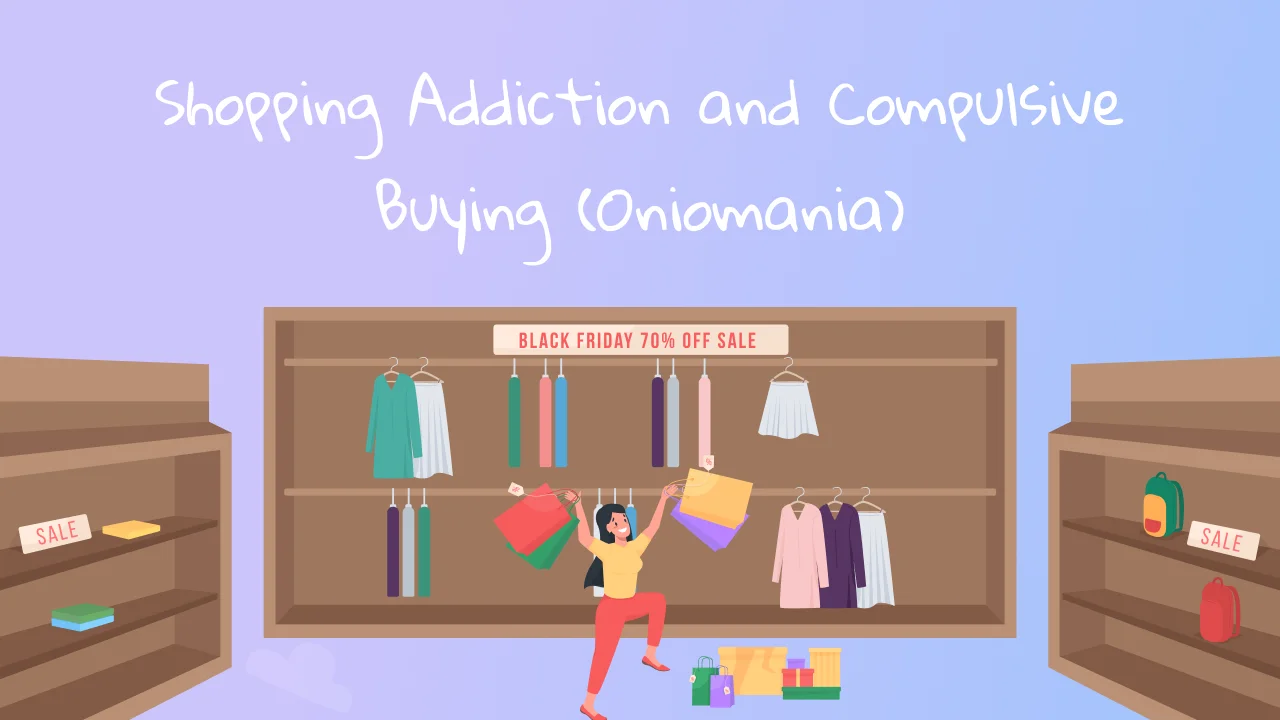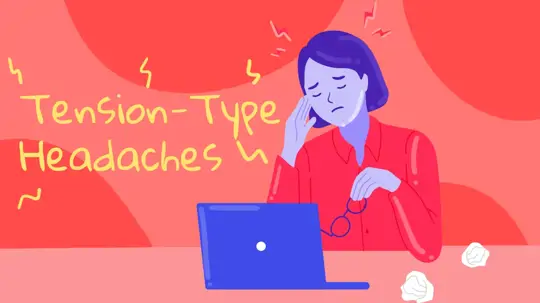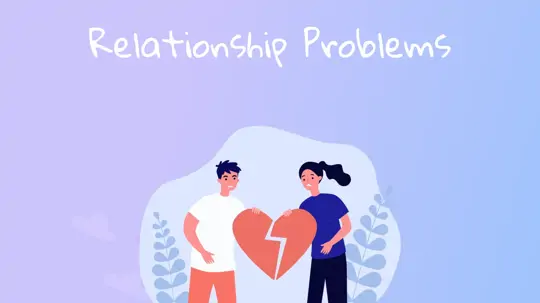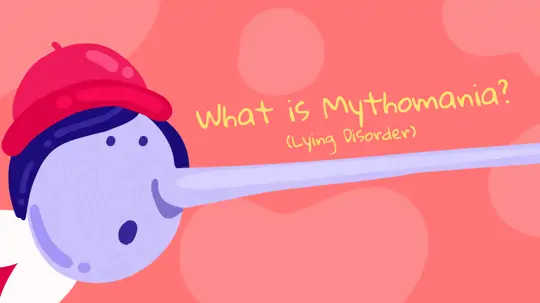
Start feeling better today!
Connect with your therapist today and take control of your life like our 850.000 happy clients.
Get StartedCompulsive Buying and Shopping Addiction (Oniomania)
Just one of millions of shopping addicts, 22-year-old Elizabeth Deiter bought nearly 100 handbags in four months. Deiter stated that she was embarrassed by the situation and that she felt very bad about shopping. "When I'm depressed, I feel compelled to shop more," she said, adding that this problem puts her marriage in jeopardy1.
Does this situation sound familiar to you? But did you know that the results of a study conducted in America indicate that 6% of women and 5.5% of men are addicted to shopping?1 So what exactly is this shopping addiction?
What is Shopping Addiction (Oniomania)?
Addiction can be defined as the repetition of a behavior despite negative consequences2, 3. Although substance and alcohol use is generally understood when addiction is mentioned, it can be said that many behaviors today are a type of addiction. Examples of these behaviors include sex, gambling, shopping, gaming, and social media use2, 4.
Although she sees shopping as a daily need, the situation where a person does it with instant desires and pleasures, even though there is no need, is considered addiction2, 6. In shopping addiction, the act of purchasing becomes more important than the product purchased2, 7.
History of Oniomania
In 1915, the term "shopping addiction" was coined by Emil Kreaplin, who defined it as "oniomania." The word "onios" means sale in Greek, while the word "mania" means madness in Greek. Although this concept emerged in 1915, its use in literature began towards the end of the 1980s2, 8.
What Causes Shopping Addiction?
There are many factors that can be counted as the cause of shopping addiction2, 9:
- A person's low self-esteem
- Negative emotions experienced along with anxiety, depression, or obsessive thoughts
- Expectation of one's social status
- One's fondness for fantasy
- Increase in internet use
- Compulsive hoarding behavior
- Unplanned buying behavior
- Gender difference (It was found that it is more common in women than men.)
Prevalence of Shopping Addiction
A study conducted in the USA in 1989 estimated the prevalence of shopping addiction to be between 2 and 8% of the population
Studies report that there is a female preponderance between 80% and 90% in clinical and community samples2, 12. Another study conducted in England in 1992 showed that shopping has a stronger emotional, psychological, and symbolic meaning for women compared to men2.

The age of onset of compulsive buying behavior was determined to be 18–30 years of age13. In a study conducted in the literature, it was stated that the age of onset actually coincides with the process of leaving the nuclear family (emancipation) and establishing one's own family13, 14.
What is Compulsive Buying?
Compulsive buying is a shopping style that puts the person in financial trouble by not being able to control this desire when he or she has a desire to buy2, 15.
We can say that the person's mental state also affects this behavior, as does feeling good in his social environment. Even if the person feels regret after shopping, he continues to maintain this behavior in order to feel better and to increase his self-confidence2, 16.
The Four Stages of Compulsive Buying
It was determined by Black et al. that there are four basic stages of compulsive buying behavior. These are as follows:13, 17
- Expectation: The person feels the urge to shop.
- Preparation: The person is preparing to go shopping. Examples include deciding where to go, what to buy, and which credit card to use.
- Shopping: This stage is the most important because the individual experiences temporary relief and great excitement while shopping at this point.
- Spending: After experiencing the buying behavior, the person regrets what he has done.
Reasons for Compulsive Buying
Research on the biological processes of addictive behaviors such as shopping addiction has provided us with some information. It has been emphasized that there are some deteriorations in the reward processing system with changes in serotonin, dopamine, endogenous opioids, and cortisol levels2, 18.
Some studies have also investigated the effects of social, economic, and familial factors on compulsive buying behavior2, 19. Some of the factors emphasized in these studies are as follows:
- Easy to use credit cards
- Increase in advertising in the media
- Television shows
- Online shopping opportunity
This also supports the case that these factors occur in high-income countries where they cause or encourage compulsive buying behavior. With the collapse of the family structure in our society and the lack of a sense of harmony in our society, individuals tend to engage in compulsive buying behavior as a behavior that alleviates their negative feelings of isolation and loneliness, albeit temporarily2.
There are also psychoanalytic theories to explain the causes of compulsive buying behavior. These theories also showed that early life events, the absence of a stable self-image, and infertility anxiety are among the factors contributing to compulsive buying behavior2, 20.
Individuals with compulsive buying behavior reported positive mood changes during the purchasing process, as well as feelings of relief and satisfaction from the act of purchasing.When they go home after the purchase, they may experience feelings such as guilt, shame, or regret.
In order to cope with these negative emotions, they may hide their buying behavior or ignore these behaviors. As a result, it was stated that the dominant emotional changes in compulsive buying behavior were sadness and euphoria2, 21.
Theoretical Structure of Shopping Behavior
Social Learning Theory and Shopping
Scientific studies show that shopping is a social behavior. Some of our buying behavior is shaped by the buying behavior of others we care about. Social learning theory is a theory that explains that our other behaviors and values, such as shopping, are based on social learning. Positive reinforcement from the person's environment or through the media goes through a learning process about which behaviors or values are more socially acceptable2, 22.
Escape Theory
It is suggested in the literature that escape theory provides the best explanation for compulsive behavior. While many people defend the escape theory as self-awareness, this defense can be quite painful. Obviously, individuals have high standards that they cannot meet, and this can lead to many negative situations such as failure, low self-esteem, anxiety, and depression.
When these feelings are also intense, the person looks for various ways to escape from this situation and to prevent painful self-awareness, at least for a certain period of time. The escape theory also tells us at this point:2, 23
- The individual with compulsive buying behavior first experiences painful self-awareness.
- Compulsive buyers tend to be perfectionists and have high standards for themselves.
- The sense of failure and negative feelings about oneself that the person perceives in his life trigger compulsive buying behavior.
- A high degree of self-improvement may characterize this condition.
- During these processes, the compulsive receiver is in the process of imaginary thinking.
- Because the compulsive buyer is preoccupied with compulsive purchases, he also hinders the long-term consequences of his behavior.

The Treatment Process
It has also been difficult to formulate strategies and methods to deal with this situation, as there is limited evidence of what works in the shopping addiction process. Although there is no evidence-based treatment, cases of treatment with antidepressants were also reported13.
Psychotherapy and Self-Help Process
Researcher Bernik et al. reported that exposure to environmental cues related to dysfunctional shopping behavior caused relapses13. Self-help books on this subject also have the purpose of helping individuals with compulsive buying behavior.
Support groups such as "Shopping Addicts Anonymous," a similar group to "Alcoholics Anonymous," also provide an environment of mutual support and encouragement among individuals with compulsive buying behavior13, 24.
In addition to these, compulsive buying behavior can also be addressed in marriage or couple therapy as it can cause various problems in relationships13, 25.
Kuzma and Black (2006) mention that self-help behavior is very important. They stated that they could not rely on a drug to treat compulsive buying behaviors in individuals and instead recommended a four-step approach in order to break these habits on their own13.
Four Steps to Control Compulsive Spending
- Recognize that you are a compulsive buyer.
- Get rid of checkbooks by cutting up credit cards.
- Shop with a friend or relative will cause you to limit your spending, along with the feeling of embarrassment.
- Strive to find meaningful ways to spend your time other than shopping13, 26.
Sources
- https://www.kimpsikoloji.com/alisveris-bagimliliginin-nedenleri-ve-cozumler/
- AYAZOĞLU, B. A., Melisa, A. K. S. U., ÜNÜBOL, H., & SAYAR, G. H. (2019). Alışveriş bağımlılığı. Etkileşim, (4), 44-64.
- Angres, D. H. ve Bettinardi-Angres, K. (2008). “The Disease of Addiction: Origins, Treatment, and Recovery”. Disease-a-Month. 54(10). 696-721.
- Griffiths, M. D. (1997). “Exercise Addiction: A Case Study”. Addiction Research. 5(2). 161-168.
- Khantzian, E. J. (1997). “The Self-Medication Hypothesis of Substance Use Disorders: A Reconsideration and Recent Applications”. Harvard Review of Psychiatry. 4(5). 231-244.
- Wormer K. V. ve Davis D. R. (2003). Addiction Treatment: A Strengths Perspective. Avustralya: Brooks/Cole.
- Weinstein, A. ve Lejoyeux, M. (2010). “Internet Addiction or Excessive Internet Use”. The American Journal of Drug and Alcohol Abuse. 36(5). 277-283.
- Kearney, M. ve Stevens, L. (2012). “Compulsive Buying: Literature Review and Suggestions for Future Research”. The Marketing Review. 12(3). 233-251.
- Iqbal, N. ve Aslam, N. (2016). “Materialism, Depression, and Compulsive Buying among University Students”. International Journal of Indian Psychology. 3(2). 91-102
- Black D. W. (2007). “Compulsive Buying Disorder: A Review of the Evidence”. CNS Spectrums. 12(2). 124-132.
- Koran, L. M., Faber, R., Aboujaoude, E., Large, M. D., Serpe, R. T. (2006). “Estimated Prevalence of Compulsive Buying Behavior in the United States”. American Journal of Psychiatry. 163(10). 1806-1812.
- Schlosser, S., Black, D. W., Repertinger, S., Freet, D. (1994). “Compulsive Buying: Demography, Phenomenology, and Comorbidity in 46 Subjects”. General Hospital Psychiatry. 16(3). 205-212.
- Murali, V., Ray, R., & Shaffiullha, M. (2012). Shopping addiction. Advances in psychiatric treatment, 18(4), 263-269.
- Black DW (2007b) A review of compulsive buying disorder. World Psychiatry 6: 14–8.
- Tamam, L., Diler, R. S., & Özpoyraz, N. (1998). Kompulsif satın alma: Bir gözden geçirme. Türk Psikiyatri Dergisi, 9(3), 224-230.
- Faber, R. J., & O'guinn, T. C. (1992). A clinical screener for compulsive buying. Journal of consumer Research, 19(3), 459-469.
- Black DW (2007a) Compulsive buying disorder: a review of the evidence. CNS Spectrums 12: 124–32.
- Grant, J. E., Brewer, J. A., Potenza, M. N. (2006). “The Neurobiology of Substance and Behavioral Addictions”. CNS Spectrums. 11(12). 924-930.
- Dell’Osso, B., Allen, A., Altamura, C., Buoli, M., Hollander, E. (2008). “Impulsive-Compulsive Buying Disorder: Clinical Overview”. Australian and New Zealand Journal of Psychiatry. 42(4). 259-66.
- Black D. W. (1996) “Compulsive Buying: A Review”. The Journal of Clinical Psychiatry. 57(ek sayı 8). 50
- Kellett, S. ve Bolton, J. V. (2009). “Compulsive Buying: A Cognitive-Behavioural Model”. Clinical Psychology and Psychotherapy. 16(2). 83-99.
- Mitchell, A. M., Jones, B. G., Krumboltz, J. D. (1979). Social Learning and Career Decision Making. Cranston, RI: Carroll Press.
- Benson, A. L. (2006). “New Perspectives on Compulsive Buying: Its Roots, Measurement and Physiology”. C. Pechmann ve C. Price (ed.) NA - Advances in Consumer Research. 33. (131-133). Duluth, MN: Association for Consumer Research.
- Levine B, Kellen B (2000) Debtors Anonymous and psychotherapy. In I Shop, Therefore I am: Compulsive Buying and the Search for Self (ed AL Benson): 431–54. Aronson.
- Mellan O (2000) Overcoming overspending in couples. In I Shop, Therefore I am: Compulsive Buying and the Search for Self (ed AL Benson): 341–66. Aronson.
- Kuzma J, Black DW (2006) Compulsive shopping: when spending begins to consume the consumer. Journal of Family Practice 5 (7) (http://www. jfponline.com/Pages.asp?AID=4266).





